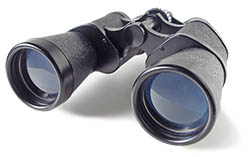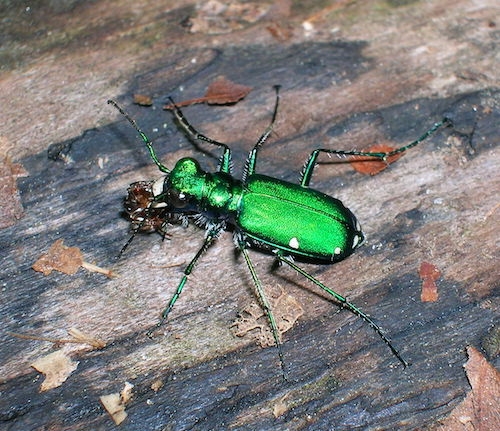show/hide words to know
Humidity: a measure of the amount of water vapor (the gas form of water) in the air, with more water creating more humid air.
How to Observe Tiger Beetles
What to look for
If you want to watch tiger beetles, look for an insect constantly running, then stopping, then running again across the open ground. They are so fast sometimes you aren’t sure you really saw them or not. Wait for them to catch a small insect in their mouth and they will be in the same place for a minute or two. While they are eating, you can get a longer, closer look at them. Try not to move quickly or to let your shadow fall across them, and you can get very close to see what they are doing and what they look like. If there are many in an area and you sit completely still near where they are running, they might run right around you and may even touch your shoe.
Look for their long legs, big eyes, and the arrangement of colors on their backs. Some tiger beetles are bright green, some are black, and others are brownish-red. Many species have patterns of light lines running across and up and down their backs. If they are frightened, they will quickly spread their hidden wings and fly away from you 10 to 20 feet. They most often land facing you.
When is the best time?
Most tiger beetles love warm or hot parts of the day during the spring, summer, and early fall. Before 8 or 9 in the morning, it's often too cold for them. If it is a cool rainy day, they may not come out at all. All day on sunny days they never seem to stop moving as they look for food and mates, while avoiding enemies that might eat them. On warm, humid nights in the middle of the summer, some species will come out and are attracted to lights. A few species are only active during the night and on cloudy days.
Where are the best places?
 Most tiger beetles love flat, open habitats. Many species are found only along the edges of muddy or sandy rivers, lakes, and oceans. Other species prefer sunny openings on the forest floor, salt flats, alpine meadows, or sand dunes. A few species only live on large, flat rocks, and some species live on the trunks of trees or leaves of bushes. If you're in a warm and humid place, look for open surfaces, and maybe you will see a tiger beetle looking back at you.
Most tiger beetles love flat, open habitats. Many species are found only along the edges of muddy or sandy rivers, lakes, and oceans. Other species prefer sunny openings on the forest floor, salt flats, alpine meadows, or sand dunes. A few species only live on large, flat rocks, and some species live on the trunks of trees or leaves of bushes. If you're in a warm and humid place, look for open surfaces, and maybe you will see a tiger beetle looking back at you.
Tools for watching – do you need binoculars?
If you can sit or stand still for ten to fifteen minutes near a tiger beetle, it will soon forget that you are there. Then you can watch it closely. If you have a pair of small binoculars that can focus 5 or 10 feet away, you can see even more of the tiger beetle’s activities. If you don’t mind getting dirty with sand or mud, you can crawl very slowly on your stomach holding a camera and get close-up pictures of these beautiful and scary-looking beetles.

Those who live or travel in the United States or Canada might want to pick up a copy of A Field Guide to the Tiger Beetles of the United States and Canada: Identification, Natural History, and Distribution of the Cicindelinae. The guide includes a large collection of color plates, range maps, and descriptions for the beginner and expert tiger beetle enthusiast.
You might want to draw pictures of them or write down what they are doing, and where and when you find them. You can count how many are running at the same place at different times of the day or in different months of the year. A notebook and pencil would be handy for in-depth tiger beetle watching. You will have a better way of remembering later on what you really saw. What you see and learn from them might be used by scientists to save habitats or other animals.
To help you know better where to search for tiger beetles and identify them with a name, you can use a book or a computer APP called a field guide. These guides have color pictures of each species. They have maps showing where each species can be found. And they have pages you can read to learn what habitats each species uses. If you read the guide enough, you will quickly learn how to look for tiger beetles and identify them all by yourself.
Additional images from Wikimedia Commons. Six-spotted tiger beetle image by TheAlphaWolf.
View Citation
Bibliographic details:
- Article: How to be a Tiger Beetle Watcher
- Author(s): Nancy Pearson, Dave Pearson
- Publisher: Arizona State University School of Life Sciences Ask A Biologist
- Site name: ASU - Ask A Biologist
- Date published: August 18, 2014
- Date accessed: April 17, 2024
- Link: https://askabiologist.asu.edu/tiger-beetle-watcher
APA Style
Nancy Pearson, Dave Pearson. (2014, August 18). How to be a Tiger Beetle Watcher. ASU - Ask A Biologist. Retrieved April 17, 2024 from https://askabiologist.asu.edu/tiger-beetle-watcher
Chicago Manual of Style
Nancy Pearson, Dave Pearson. "How to be a Tiger Beetle Watcher". ASU - Ask A Biologist. 18 August, 2014. https://askabiologist.asu.edu/tiger-beetle-watcher
Nancy Pearson, Dave Pearson. "How to be a Tiger Beetle Watcher". ASU - Ask A Biologist. 18 Aug 2014. ASU - Ask A Biologist, Web. 17 Apr 2024. https://askabiologist.asu.edu/tiger-beetle-watcher
MLA 2017 Style

Six Spotted Tiger beetle (Cicindela sexguttata) eating an ant.
Be Part of
Ask A Biologist
By volunteering, or simply sending us feedback on the site. Scientists, teachers, writers, illustrators, and translators are all important to the program. If you are interested in helping with the website we have a Volunteers page to get the process started.







